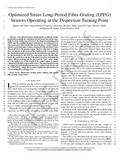Mostrar el registro sencillo del ítem
Optimized strain long-period fiber grating (LPFG) sensors operating at the dispersion turning point
| dc.creator | Del Villar, Ignacio | es_ES |
| dc.creator | Fuentes Lorenzo, Omar | es_ES |
| dc.creator | Chiavaioli, Francesco | es_ES |
| dc.creator | Corres Sanz, Jesús María | es_ES |
| dc.creator | Matías Maestro, Ignacio | es_ES |
| dc.date.accessioned | 2018-03-27T10:29:37Z | |
| dc.date.available | 2019-01-08T00:00:12Z | |
| dc.date.issued | 2018 | |
| dc.identifier.citation | I. Del Villar, O. Fuentes, F. Chiavaioli, J. M. Corres and I. R. Matias, "Optimized Strain Long-Period Fiber Grating (LPFG) Sensors Operating at the Dispersion Turning Point," in Journal of Lightwave Technology, vol. 36, no. 11, pp. 2240-2247, June1, 1 2018. doi: 10.1109/JLT.2018.2790434 | en |
| dc.identifier.issn | 0733-8724 (Print) | |
| dc.identifier.issn | 1558-2213 (Electronic) | |
| dc.identifier.uri | https://hdl.handle.net/2454/28064 | |
| dc.description.abstract | Two phenomena for enhancing the sensitivity of longperiod fiber gratings are combined toward an increase of the sensitivity to strain of this type of devices: the dispersion turning point (DTP) and the cladding diameter reduction by an etching process. The results prove that sensitivities up to 20 pm/με can be attained, which is a ten-fold improvement compared to the previous works. The sensitivity in the grating region, which is subjected to etching, does not depend on the order of the cladding mode responsible for the attenuation bands generated in the transmission spectrum, but on the proximity to the DTP for each mode order. On the other hand, the sensitivity to strain of the global structure, including the region without etching, can be increased for lower order modes in a perceptible way if the length of the etched region is smaller compared to the fiber region under stress. The experimental results are supported with simulations based on coupled-mode theory and on FIMMWAVE, which allows understanding the phenomena involved during the sensing process. | en |
| dc.description.sponsorship | This work was supported in part by the Spanish Ministry of Economy and Competitiveness (TEC2016-78047-R – AEI/FEDER, UE), in part by the Government of Navarra PI044 NANOSEN, and in part by the Pinar del Río University. | en |
| dc.format.mimetype | application/pdf | en |
| dc.language.iso | eng | en |
| dc.publisher | IEEE | en |
| dc.relation.ispartof | Journal of Lightwave Technology Vol. 36, No. 11, June 1 2018 | es_ES |
| dc.rights | © 2018 IEEE. Personal use of this material is permitted. Permission from IEEE must be obtained for all other uses, in any current or future media, including reprinting/republishing this material for advertising or promotional purposes, creating new collective works, for resale or redistribution to servers or lists, or reuse of any copyrighted component of this work in other works. | en |
| dc.subject | Dispersion turning point | en |
| dc.subject | Etching | en |
| dc.subject | Long period fiber grating | en |
| dc.subject | Strain sensor | en |
| dc.title | Optimized strain long-period fiber grating (LPFG) sensors operating at the dispersion turning point | en |
| dc.type | Artículo / Artikulua | es |
| dc.type | info:eu-repo/semantics/article | en |
| dc.contributor.department | Ingeniería Eléctrica y Electrónica | es_ES |
| dc.contributor.department | Ingeniaritza Elektrikoa eta Elektronikoa | eu |
| dc.contributor.department | Institute of Smart Cities - ISC | es_ES |
| dc.rights.accessRights | Acceso abierto / Sarbide irekia | es |
| dc.rights.accessRights | info:eu-repo/semantics/openAccess | en |
| dc.embargo.terms | 2019-01-08 | |
| dc.identifier.doi | 10.1109/JLT.2018.2790434 | |
| dc.relation.projectID | info:eu-repo/grantAgreement/ES/1PE/TEC2016-78047-R | en |
| dc.relation.publisherversion | https://doi.org/10.1109/JLT.2018.2790434 | |
| dc.type.version | Versión aceptada / Onetsi den bertsioa | es |
| dc.type.version | info:eu-repo/semantics/acceptedVersion | en |
| dc.contributor.funder | Gobierno de Navarra / Nafarroako Gobernua | es |


